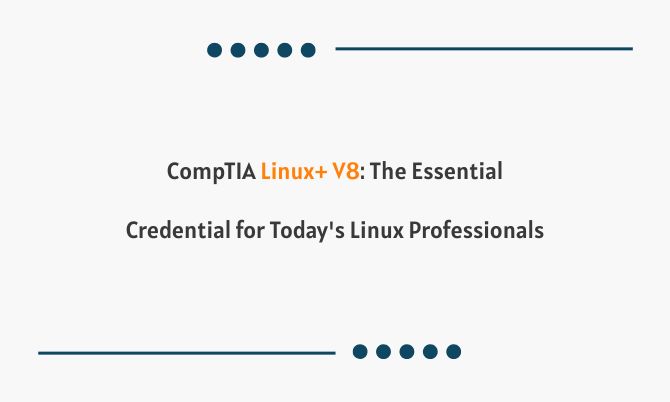As Linux continues to be foundational in cloud computing, enterprise infrastructure, and DevOps workflows, CompTIA has responded with a major update: Linux+ V8 (exam code XK0-006), launched on July 15, 2025. This new version of the Linux+ certification reflects the evolving demands in systems administration, security, automation, and containerization. Here’s what you need to know about Linux+ V8 - its scope, structure, skills, and significance - and how to prepare for it.

CompTIA positions Linux+ V8 as a credential for professionals who can manage, secure, automate, and troubleshoot Linux systems in modern cloud and hybrid environments.
It’s intended for roles such as:
●Linux systems administrator
●Systems engineer
●Network engineer
One of the distinguishing features of the V8 update is the increased emphasis on automation/orchestration and containers - reflecting how real-world Linux operations increasingly rely on tools like Ansible, Docker, and CI/CD.
Here are the key technical details of the Linux+ V8 exam:
Number of questions: Up to 90 (multiple-choice and performance-based)
Duration: 90 minutesPassing score: 720 (on a scale of 100–900)
Language: English
Recommended experience: ~12 months hands-on Linux, or knowledge equivalent to CompTIA A+, Network+, or Server+
Estimated retirement: Around 2028 (≈ 3 years after launch)
Because the exam includes performance-based elements, hands-on practice (not just theory) is essential to succeed.
Linux+ V8 is organized into four major domains. Here's a breakdown of what each domain covers and how heavily it’s weighted:
System Management - 23% Topics include boot process, kernel and filesystems, device management, storage (LVM, RAID), networking setup, shell operations, backups/restores, and virtualization.
Services & User Management - 20% You’ll work with permissions, user and group management, process control, package management, system services, and container fundamentals.
Security - 18% This domain focuses on authentication and accounting (PAM, LDAP, Kerberos), firewalls (iptables, nftables, UFW), OS hardening, password policies, encryption, and compliance.
Automation, Orchestration, & Scripting - 17% Expect to automate tasks with Ansible, Puppet, CI/CD practices; write shell and basic Python scripts; and use version control (Git).
Troubleshooting - 22% The exam tests your ability to diagnose system, storage, networking, firewall, performance, and security issues - including analyzing logs, resource utilization, SELinux, permissions, etc.
By preparing for and earning Linux+ V8, you’ll strengthen your ability to:
Configure and manage core Linux systems: file systems, networking, services, VMs/containers in hybrid/cloud environments
Enforce security best practices: hardening, identity & access management, encryption, firewalling, audit/compliance
Automate administration tasks: using shell scripts, Python, Ansible, version control systems Deploy and manage containers: work with container runtimes, images, networks
Troubleshoot effectively: resolve issues related to boot, storage, performance, networking, and security Altogether, these capabilities align closely with what modern operations and site reliability roles demand.
The V8 iteration of Linux+ is a strategic refresh designed to ensure the credential keeps pace with the changing IT landscape:
Greater focus on automation & containers - reflecting real-world requirements in DevOps, SRE, and cloud infrastructure
Performance-based elements - pushing exam takers to develop hands-on skills, not just multiple-choice theory
Updated domain coverage - ensuring newer technologies and best practices are included
Relevant validation cycle - with a ~3-year lifecycle, the certification is kept current with evolving trends
For employers, having staff certified in Linux+ V8 ensures alignment with modern demands: the ability to manage, secure, and optimize Linux systems in cloud/hybrid contexts.
If you're planning to take Linux+ V8, here are some recommended approaches:
Hands-on practice is essential Since performance-based tasks are part of the exam, working directly with Ubuntu, CentOS, or other Linux distros on live systems (VMs or cloud instances) is critical.
Focus on the domains in proportion Use the percentage weights as guidance - don't neglect the lower-weighted areas (e.g. Automation & Scripting) because they can still make or break your exam performance.
Use structured training & bundles CompTIA offers exam bundles, training, and resources tied to Linux+ V8.
Also explore third-party courses, labs, and simulators that include performance tasks.
Review exam objectives carefully The official objectives list is your syllabus. Use it to map your study plan.
Time your preparation Given the exam is 90 minutes with up to 90 questions, pacing and familiarity with performance tasks are important.
Stay current until retirement date The estimated retirement is ~2028, so make sure the version is still valid when you plan to test.
The release of CompTIA Linux+ V8 marks an important refresh - aligning the certification with modern IT demands around automation, containers, cloud/hybrid systems, and real-world troubleshooting. For IT professionals seeking to validate or upgrade their Linux skills, V8 offers a timely, relevant credential.